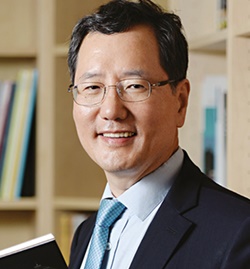4th Industrial Revolution and Jobs
The most important issue in the Fourth Industrial Revolution is jobs. Various institutes, including overseas institutes, such as the Oxford Research Institute and the Davos Forum, and Korean institutes, such as the Labor Institute and Employment Information Office, are presenting bleak prospects relating to the disappearance of jobs. Their contents show that artificial intelligence and robots will take away more human jobs. Now I would like to discuss the fundamental problems regarding the Fourth Industrial Revolution and jobs.
Over the past 250 years of the Industrial Revolution, arguments have persisted that technological innovation will eliminate jobs, but there has never been a case where technological innovation has actually reduced the availability of jobs. The 'Luddite' movement, the machine-destroying movement that occurred in the early 19th century, which coincided with the period of the First Industrial Revolution, and Time Magazine’s prediction of job extinction due to automation in 1961, which came in the early days of the Third Industrial Revolution, have proven untrue over time. The agricultural population, which was once at 80%, has shrunk to 2%, but 78% of the agricultural population found new jobs in the manufacturing and service industries, successfully dodging unemployment. That is to say that technological innovation—to this point—has not negatively affected employment. On the contrary, the fact that technological innovation has improved the quality of life and created new jobs by increasing productivity and reducing work hours is a historical truth that we must acknowledge.
Such arguments that jobs will disappear because of technological innovation are based on the law of invariability of total labor quantity. This states that, if the total amount of labor is constant, new technological innovation will result in decreased demand for jobs by reducing the total amount of labor.
In reality, the 80 hours of work per week in the early days of the Industrial Revolution have now been reduced to less than 40 hours a week. But the total amount of labor has changed. Whenever technological innovation increases productivity and surplus products are generated, new jobs emerge to meet and match human desires.
Innovation is the word that represents the extinction and creation of jobs. Since jobs often disappear and are newly created, the essential question regarding job problems refers to whether new jobs are actually being created, and not what jobs are disappearing. Most forecasting institutes talk about jobs disappearing, but these institutes’ comments on newly created jobs are harder to find.
The essential question must then consider the source of job creation. Human desire has long been overlooked as the underlying source of jobs. The infinite desire of humans has shown that the law of invariability of total labor quantity is erroneous, as demonstrated through the history of the Industrial Revolution over the last 250 years. The First Industrial Revolution, as a revolution that satisfied the human desire to survive, solved the problem of the necessities of human life through machine technology.
The Second Industrial Revolution, as a revolution that satisfied the human desire for stability, that is, the desire for convenience, provided convenient products such as refrigerators and washing machines using electrical technology. And the Third Industrial Revolution, as a result of satisfying connections through human social desires and internet technology, brought about social phenomena such as 'taking a meal alone' and 'drinking alone.' By the way, such human desires satisfied by the Industrial Revolutions to this point have directly corresponded to the 1st, 2nd, and 3rd stages of the five stages of human desires, which were put forward and promoted by Abraham Maslow.
Then, I suggest the hypothesis that the human desire for the Fourth Industrial Revolution to satisfy is the very desire of self-expression, which is the 4th stage of Maslow's desires. Maslow expanded the five stages to seven by dividing this 4th stage again into cognitive desire and aesthetic desire. Now, the source of new jobs will be rooted in the human desire for personalized self-expression, and society will evolve into a society that satisfies this personalized desire through the collaboration of humans, artificial intelligence, and robots.
The Fourth Industrial Revolution will create jobs reducing the total amount of labor due to increased productivity by making artificial intelligence and robots, along with jobs that increase the total amount of labor to satisfy the desire for self-expression. Jobs with increased productivity will reduce work hours, and jobs of self-expression will further play a role in creating new jobs.
In the midst of this Fourth Industrial Revolution, humans and artificial intelligence will learn to cooperate, taking on creative and repetitive tasks respectively. Artificial intelligence technology, so-called 'Deep Learning,' is based on repeated data. Simply put, repetitive simple tasks are left to artificial intelligence and robots, while humans will be immersed in self-creative works. In other words, future talented individuals can be defined as 'cooperative geeks.' Future education should be converted into cooperative creative talent education.
These 'cooperative geeks' are created through Project-Based Learning (PBL), in which the industry and education are integrated. The world’s leading universities are already moving towards team project education, while existing departmental education is being converted into online education (MOOC). Once again, jobs do not disappear in the Fourth Industrial Revolution; they simply change forms.
 |
Dr. Lee, Minwha
Professor / KAIST
Chairman/ KCERN
필자 / 이민화 KAIST 교수 newswj@naver.com
<저작권자 © 노벨사이언스, 무단 전재 및 재배포 금지>



 간단한 공정으로 이산화탄소 분리 성공
간단한 공정으로 이산화탄소 분리 성공








